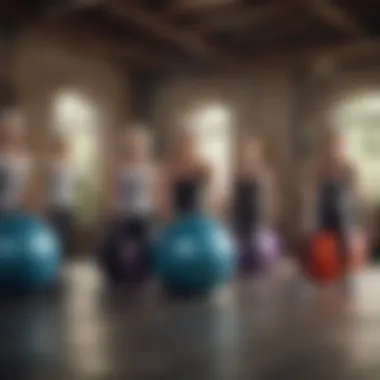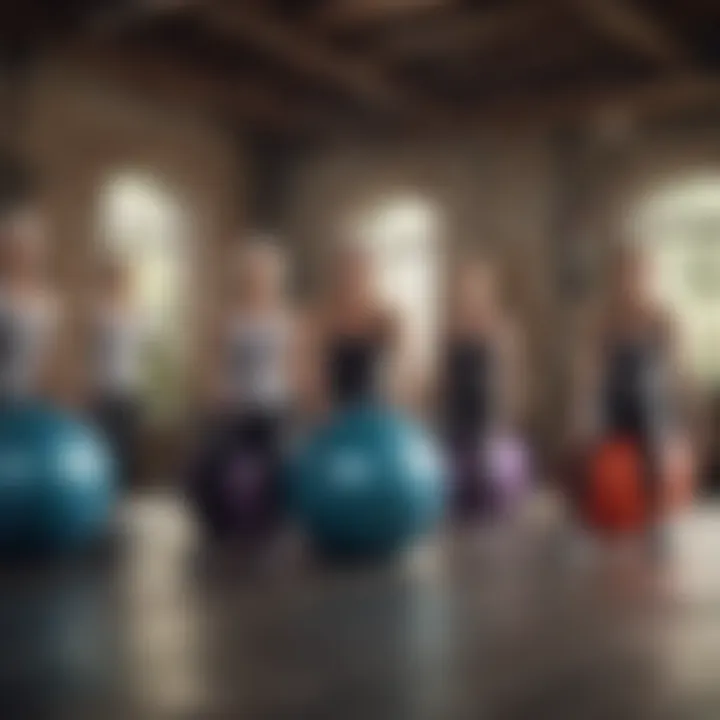Essential Balance and Stability Exercises for Seniors


Intro
Aging carries a range of physiological changes that can significantly impact one's sense of balance and overall stability. For seniors, maintaining these crucial physical abilities is essential not only for safety but also for quality of life. Exercises designed to improve balance and stability are vital in mitigating falls and enhancing mobility. These exercises do not only help in physical functioning but can also contribute to improved mental well-being. Recognizing the importance of such activities allows seniors to actively engage in preserving their independence and enhancing their daily experiences.
Key Benefits
Participating in balance and stability exercises offers numerous advantages. This section provides insight into the most important benefits for seniors.
Physical Health Benefits
- Fall Prevention: One of the most significant threats to seniors is the risk of falls. Exercises that focus on balance help strengthen muscles, improve coordination, and enhance proprioception, leading to a lower chance of falls.
- Improved Coordination: As people age, coordination tends to decline. Engaging in specific exercises can counteract this process and enhance the ability to perform everyday tasks with more ease.
- Enhanced Mobility: Stability exercises promote better movement patterns. This can lead to improved gait and ease of locomotion, enabling seniors to navigate their environments with confidence.
- Strength Gains: Many balance exercises also target major muscle groups. Strengthening these muscles supports better overall physical health and supports daily functions such as climbing stairs or standing up from a chair.
Mental Well-being Enhancements
- Confidence Boost: Improved balance results in increased confidence levels among seniors. The knowledge that they can move safely and maintain stability inevitably enhances self-esteem.
- Cognitive Engagement: Balance exercises often require focus and concentration. This cognitive engagement can lead to mental clarity and improved memory, fostering overall brain health.
- Stress Reduction: Physical activity is known to lower stress hormones in the body. Regular engagement in balance and stability exercises can promote relaxation and a more positive mood.
- Social Interaction: Group exercises can provide social benefits. Participating in classes or groups focusing on balance can help build a sense of community and decrease feelings of isolation.
Practical Tips
To maximize the benefits of balance and stability exercises, some practical guidelines can enhance effectiveness and sustainability.
Effective Meal Planning
- Balanced Diet: Seniors should focus on a balanced diet rich in fruits, vegetables, whole grains, lean proteins, and good fats. Nutritional integrity supports overall health and recovery post-workout.
- Hydration: Staying hydrated is crucial for physical performance. Aim for adequate water intake throughout the day, especially before and after exercise.
- Supplements: Consider incorporating vitamin D and calcium supplements if dietary intake is insufficient. These nutrients are key for bone health and can support physical activity.
Quick and Efficient Workouts
- Short Sessions: Aim for shorter, more frequent workout sessions rather than long, exhaustive ones. This helps maintain motivation and reduces fatigue.
- Incorporating Balance into Daily Life: Simple tasks can be transformed into balance exercises. Standing on one leg while brushing teeth or practicing heel-to-toe walking can be effective.
- Using Equipment: Items like balance boards, stability balls, or resistance bands can add variety and challenge to workouts, making them more engaging and effective.
"Regular practice of balance exercises can lead to a more independent lifestyle and improved health outcomes for seniors."
By implementing these strategies into their routine, seniors can make significant strides in their physical and mental health, leading to lasting benefits.
The Importance of Balance and Stability
Establishing and preserving balance and stability is crucial for seniors. As people age, their physical abilities naturally decline. This decline can lead to instability, making seniors more susceptible to falls and accidents. When balance is compromised, it affects not only physical safety but also mental well-being. Seniors often experience anxiety around falling, which can further hinder their mobility and independence. Thus, promoting balance and stability is essential for enhancing quality of life.
Understanding Balance in Seniors
Balance is defined as the ability to maintain an upright posture while standing still or moving. For seniors, balance can be influenced by several factors including muscle strength, joint mobility, and nervous system function. Age-related changes in these areas can lead to postural instability, which puts seniors at risk. By understanding that balance encompasses more than just physical positioning, seniors can focus on improving their overall stability through various exercises.
Seniors often have a weaker proprioceptive sense, which makes it harder to perceive body positioning. This can lead to a lack of coordination. Engaging in balance exercises helps enhance proprioception. Simple activities like standing on one leg or practicing stepping over objects can stimulate the body’s balance mechanism.
Consequences of Poor Balance
Poor balance can result in serious consequences for seniors. The most immediate risk is that of falling. Falls are the leading cause of injury among older adults. They can cause fractures, especially in the hip, wrist or spine. Moreover, falls can result in trauma to the head, leading to life-altering cognitive or mobility issues.
The fear of falling can also create a cycle of reduced physical activity. Seniors who are worried about falling may avoid movement, leading to further decline in strength and stability. This inability to remain active contributes to into a sedentary lifestyle, increasing overall health risks. Elderly individuals may also experience feelings of isolation due to a limited willingness to engage in social activities. Just as physical consequences arise from poor balance, emotional and mental health can decline as well.
Surveys show that those who lack stability often report dissatisfaction with their quality of life. Therefore, balance exercises are not only key to avoiding physical injury, but also to maintaining mental health and social engagement.
The Role of Stability in Daily Life
Stability is essential in the daily activities of seniors. Simple movements, like getting out of a chair, walking, or even turning around can become challenging without adequate stability. For seniors, these tasks may seem trivial, but they’re fundamental for independence. Improving stability enables seniors to perform these activities with greater ease and confidence.
Engaging in stability exercises enhances core strength, which plays a significant role in maintaining a solid and balanced posture. When seniors have a strong core, they are less likely to experience instability in various movements. This connection illustrates that stability extends beyond just physical conditioning; it contributes to maintaining independence and lowering the risk of accidents.
Furthermore, having improved stability can foster a positive attitude toward physical activity. Feeling confident in one’s ability to move safely leads to increased participation in social activities, group classes, and community engagements. This can create a supportive environment that uplifts seniors, promoting overall well-being.
"Physical fitness is not only one of the most important keys to a healthy body, it is the basis of dynamic and creative intellectual activity." - John F. Kennedy
In summary, focusing on balance and stability is necessary for seniors to maintain dignity and independence in their daily lives.
Physiological Changes Affecting Balance
Understanding the physiological changes that occur with aging is crucial for enhancing balance and stability in seniors. As people grow older, their bodies undergo various transformations that can significantly impact their ability to maintain equilibrium. Recognizing these changes allows one to formulate exercise programs that can effectively address balance issues, promoting safety and overall well-being.
Muscle Mass Decline
One of the most notable changes in seniors is muscle mass decline, a condition known as sarcopenia. It often starts around the age of 30 and accelerates after the age of 60. Muscle weakness can lead to decreased stability, making it harder for seniors to perform daily activities without assistance.
Strength training exercises can mitigate this decline by promoting muscle growth and strength retention. By lifting weights or engaging in resistance training, seniors can rebuild and maintain their muscle mass, thereby enhancing their overall balance.
- Benefits of Strength Training for Seniors:
- Improves muscle mass
- Increases bone density
- Enhances metabolic health
Joint Mobility and Flexibility
Another significant factor affecting balance is joint mobility and flexibility. As individuals age, cartilage can wear down, leading to stiff joints. Conditions like arthritis can further hinder mobility. When joints lack flexibility, it can result in a compromised ability to shift weight effectively, increasing the likelihood of falls.
Incorporating flexibility and stretching exercises can help seniors improve their range of motion. Activities like yoga and Pilates gently promote flexibility. Key stretches for seniors include:
- Neck stretches
- Shoulder rolls
- Hip openers
Improving flexibility can mean safer movements and a decreased chance of injury when navigating through their environments.
Neurological Factors
Neurological factors also play a crucial role in balance. Sensory nerves provide vital information about the body's position and movement. However, with aging, there is often a decline in these sensory functions, which can impede coordination and balance. This decline may lead to slower reaction times to potential falls or hazards.
Engaging in exercises that stimulate both the body and mind can enhance neurological function. Activities such as tai chi or balance-specific exercises encourage coordination and focus, thereby improving stability.


Regular engagement in balance exercises can create neuromuscular adaptations that enhance overall stability. Improving the body's ability to respond to changes can mitigate the risk of falls.
Recognizing and addressing these physiological factors can lead to more effective balance and stability training. This proactive approach is essential for maintaining a high quality of life as one ages.
Types of Exercises for Balance and Stability
Exercises designed for balance and stability hold immense importance in the lives of seniors. Regular participation in these exercises can strengthen muscles, enhance flexibility, and improve coordination. Each type serves a distinct purpose yet contributes collectively to better overall stability. The selection should consider the individual’s current fitness levels, potential health issues, and personal preferences.
Strength Training
Strength training plays a vital role in improving balance and stability for seniors. This type of exercise focuses on building muscle and enhancing its function. With age, muscle mass tends to decline, leading to weakened strength. By incorporating light weightlifting or resistance bands, seniors can effectively counteract this decline.
- Benefits of Strength Training
- Increases muscle mass which supports joint health.
- Enhances bone density, reducing the risk of fractures.
- Improves confidence in movement due to increased strength.
Regularly engaging in strength training routines can significantly improve posture and stability, thus mitigating a senior's risk of falls.
Flexibility and Stretching Exercises
Flexibility exercises are essential for maintaining joint mobility and balance. As joints can become stiff with age, incorporating stretching can alleviate tightness and increase the range of motion. Stretching exercises such as gentle yoga or simple range-of-motion movements keep the body agile and prepared for daily activities.
- Key Reasons to Include Flexibility Exercises:
- Enhances overall movement efficiency.
- Reduces muscle soreness post-exercise.
- Promotes overall relaxation, which can be beneficial mentally and physically.
Dedicated flexibility routines can also facilitate smoother transitions from sitting to standing, ultimately enhancing stability.
Balance-Specific Exercises
Balance-specific exercises are at the core of improving stability for seniors. These exercises are designed explicitly to enhance proprioception, which is the body’s ability to sense its position in space. Engaging in activities like tai chi, standing on one foot, or practicing weight shifts directly targets balance improvements.
- Advantages of Balance-Specific Exercises:
- Increases body awareness, which helps in the prevention of falls.
- Builds confidence in activities of daily living.
- Engages both mental and physical faculties, keeping seniors mentally sharp.
By regularly practicing these exercises, seniors establish a sense of stability that can significantly improve their mobility and independence.
Functional Training
Functional training bridges the gap between exercise and daily life activities. It focuses on strengthening muscles through movements mimicking routine tasks like climbing stairs, lifting objects, or getting out of a chair. This approach is particularly effective in improving balance and stability because it relates directly to real-world applications.
- Benefits of Functional Training:
- Promotes effective movement patterns in everyday tasks.
- Fosters independence by making daily activities easier.
- Enhances coordination and balance through practical integration.
Participating in functional training offers significant gains, helping seniors feel more secure in their day-to-day lives.
Through a well-rounded approach that includes strength training, flexibility exercises, balance-specific activities, and functional training, seniors can attain better balance and stability. The inclusion of diverse exercise types ensures that seniors remain engaged and motivated while encouraging a healthier lifestyle.
Balance Exercises for Seniors
In the context of maintaining physical conditioning among seniors, balance exercises hold significant importance. Aging naturally affects one’s equilibrium and coordination. Therefore, engaging in targeted balance exercises offers a straightforward approach to mitigate risks associated with falls, which are prevalent in this age group. Strong balance enhances mobility, which in turn contributes to greater independence and quality of life.
The benefits of engaging in balance exercises extend far beyond mere physical stability. They can lead to improvements in mental well-being, providing a sense of accomplishment and confidence. Furthermore, when seniors practice such exercises regularly, they promote muscle engagement, stimulating bodily systems crucial for maintaining functional movements in daily tasks.
When considering balance exercises, it is essential to ensure that they are tailored to the individual's existing capabilities. Factors such as current health conditions, previous injuries, and overall fitness levels should inform the selection of specific exercises. Engaging in appropriate activities can ultimately lead to more effective outcomes, making balance exercises a vital component of senior fitness routines.
Single-Leg Stands
Single-leg stands are simple yet effective exercises that improve stability and strength. To perform this exercise, a senior can stand straight next to a sturdy object for support, if necessary. Then, they lift one foot off the ground, balancing on the other for a set period. Starting with a few seconds and gradually increasing the time can enhance balance skills. Notably, this exercise not only strengthens the ankles but also engages core muscles, crucial for stability.
Heel-to-Toe Walks
Heel-to-toe walks serve as another beneficial balance exercise. This exercise involves walking in a straight line, ensuring the heel of one foot touches the toes of the other foot with each step. This movement helps improve coordination and enhances the body's awareness of spatial positioning. It can be performed in a hallway or outdoors, and it is advised to have a handrail or wall nearby for safety. As with all exercises, practicing heel-to-toe walks regularly leads to significant improvements over time.
Standing on One Foot
Standing on one foot combines strength and balance building. Seniors can practice this by shifting their weight onto one leg while lifting the other leg slightly off the ground. Maintaining this position can be challenging at first, so using a chair or a wall for balance is a practical measure. Holding this position for several seconds, resting, and repeating with the other foot can gradually enhance balance over time. This exercise mimics real-life scenarios where standing on one foot may be necessary, such as while dressing or reaching for objects.
Regular practice of balance exercises not only reduces the risk of falls but also empowers seniors with the confidence to engage in daily activities more freely.
Stability Exercises for Seniors
Stability exercises are a crucial component of any fitness regimen for seniors. These exercises focus not only on improving strength and coordination but also on enhancing the ability to maintain posture and balance during daily activities. As individuals age, the risk of injury from falls increases significantly. Thus, incorporating stability exercises into a senior's routine can aid in preventing injuries and promote greater independence.
The benefits extend beyond mere physical safety. Engaging in stability exercises helps seniors gain confidence in their movement, which can enhance their overall quality of life. Regular practice of these exercises can lead to improved mobility, better coordination, and the ability to perform daily tasks with ease. Seniors often report feeling more secure and self-assured when navigating their environment.
However, it is important to approach stability exercises thoughtfully. Some seniors may have preexisting health conditions, such as arthritis or osteoporosis, which could affect their ability to perform certain movements. Consulting with a health professional before starting any exercise routine is highly recommended. Additionally, exercises can be adjusted or modified to meet individual needs, ensuring that all seniors can participate safely.
Chair Stand
The chair stand is a simple yet effective exercise that helps to strengthen the legs and improve stability. To perform this exercise, position a sturdy chair without wheels in a safe area. Seniors should sit all the way back in the chair with their feet flat on the ground, about shoulder-width apart.
- Starting Position: Sit up straight with feet flat, arms at the sides or crossed over the chest.
- Movement: Push through the heels and stand up using the strength of the legs. Fully rise until standing straight.
- Return: Gradually lower back down to sitting position.
- Repetition: Aim for 10 repetitions, rest, and then repeat a couple more sets.
This exercise not only targets the major muscle groups of the lower body but also enhances the ability to transition from sitting to standing, a movement often taken for granted.
Wall Push-ups
Wall push-ups are a great way to build upper body strength while maintaining core stability. They are particularly useful for seniors, as they are less demanding on the joints compared to traditional push-ups.
- Position: Stand facing a wall, about an arm's length away.
- Hand Placement: Place hands on the wall at shoulder height and shoulder-width apart.
- Movement: Lean towards the wall by bending the elbows while keeping the body straight.
- Return: Push back to the starting position by straightening the arms.
- Repetition: Start with 5-10 repetitions and increase as strength improves.


Wall push-ups help improve upper body strength and stability, making it easier for seniors to perform daily tasks that require pushing or lifting.
Step-Ups
Step-ups can significantly enhance balance and leg strength. This exercise conditions the muscles used for climbing stairs, a common activity that many seniors might struggle with.
- Equipment: Use a sturdy step or platform, approximately 4 to 6 inches high.
- Movement: Step onto the platform with one foot, firmly placing the entire foot on the step.
- Follow Through: Lift the other foot and step up fully onto the platform, then step back down one foot at a time.
- Repetition: Complete 10 repetitions on one side, then switch to the other side.
The step-up exercise improves coordination and mimics movements found in daily life, encouraging seniors to maintain their mobility.
Incorporating Balance and Stability into Routine
Incorporating balance and stability exercises into the daily routines of seniors is essential for enhancing physical health and preventing falls. The significance of this integration lies not only in physical wellbeing but also in fostering mental resilience and confidence. By making balance and stability a regular aspect of their lives, seniors can achieve greater independence and live more safely. Key benefits of such incorporation include muscle strengthening, improved coordination, and heightened awareness of their body in space.
Creating a Weekly Schedule
Establishing a weekly schedule for balance and stability exercises promotes consistency. Aim to set aside time each week dedicated to these activities. A good strategy might involve selecting specific days and times when one feels most energetic.
- Start with at least two to three days a week.
- Each session can last from 20 to 30 minutes.
- Gradually increase both frequency and duration as strength improves.
Having a routine not only instills discipline but also helps track progress. Consider using a calendar or a simple checklist. This way, one can visually see the commitment to improving balance.
Integrating with Existing Activities
It is practical to merge balance exercises with existing daily activities. For instance, if a senior has a regular walking schedule, they might include heel-to-toe walking for part of that time. Other examples include:
- Practicing single-leg stands while brushing teeth.
- Performing chair stands during TV commercials.
- Doing wall push-ups during breaks from seated tasks.
Integrating exercises in this manner enhances their relevance and helps seniors perceive these activities as less of a chore. This can make them more enjoyable and easier to maintain.
Finding the Right Environment
Selecting an appropriate environment to practice balance and stability exercises is critical. A safe, familiar, and supportive space can make all the difference. Essential considerations include:
- Avoid clutter: Make sure the area is clear of obstacles.
- Comfort: Ensure that the space has adequate lighting and is free from distractions.
- Social support: If possible, engage in exercises in a group or with friends. This can provide motivation and encouragement.
"Working out in a comfortable and secure environment enhances commitment and participation in balance exercises."
By taking time to think about these factors, seniors can create a positive atmosphere that encourages them to engage in balance and stability activities consistently.
Safety Considerations
Ensuring safety during balance and stability exercises is paramount, especially for seniors. As age progresses, the likelihood of falls and injuries can increase significantly. Therefore, it is essential to take a proactive approach to create a safe exercise environment. This section explores critical safety considerations that should be prioritized to maximize benefits while minimizing risks associated with these exercises.
Assessing Health Conditions
Before beginning any exercise program, seniors should undergo a thorough health assessment. This examination can identify existing medical conditions that may impact physical activity. Key areas to evaluate include:
- Current Medications: Some medications may affect balance or coordination.
- Chronic Conditions: Conditions such as arthritis or cardiovascular diseases can limit mobility.
- Vision and Hearing Issues: These senses play a crucial role in balance and should be regularly checked.
Seniors are encouraged to consult with their healthcare team, which might include a physician or physical therapist. This ensures that exercises are tailored to their individual health needs, enhancing safety in practice.
Using Supportive Equipment
Supportive equipment can serve as vital tools in maintaining safety during balance exercises. For seniors, these items can offer additional stability and confidence. Common supportive equipment includes:
- Handrails: Install handrails in areas where exercises are performed, especially near steps or thresholds.
- Balance Balls: These can be used under supervision to enhance core strength and stability without the risk of falling.
- Yoga Mats: A stable surface can help prevent slips during exercises like stretches or single-leg stands.
- Fitness Trackers: These devices can help monitor physical activity levels and encourage seniors to stay active safely.
Using these pieces of equipment correctly can significantly reduce the risk of falls, enabling seniors to practice exercises with greater confidence.
Correcting Form and Technique
Proper form and technique are crucial in all fitness routines, particularly for balance and stability exercises. Incorrect form can lead to strain or injury, negating the positive effects of the workouts. Here are some considerations for maintaining correct form:
- Start Slow: Seniors should ease into exercises, allowing their bodies to adjust.
- Seek Professional Guidance: Engaging with fitness trainers or physical therapists can help ensure proper technique.
- Regular Feedback: Encourage self-assessment and peer feedback to identify form imperfections.
- Visual Aids: Using mirrors during exercises can help seniors observe their movements and adjust as necessary.
By emphasizing correct form and technique, seniors can derive maximum benefit from their balance training while significantly reducing the likelihood of injury.
Safety is not just a practice; it is a vital element that enhances the quality of life for seniors through increased confidence and encourages regular participation in physical activities.
In summary, safety considerations are essential for seniors engaging in balance and stability exercises. Through health assessments, the use of supportive equipment, and a focus on technique, seniors can safely enhance their physical well-being.
Tracking Progress and Adjustments
Tracking progress and making necessary adjustments are essential components of a successful exercise routine for seniors focusing on balance and stability. Maintaining a detailed record of performance allows individuals to recognize improvements, setbacks, and areas needing further attention. Insightful evaluations inspire motivation and clarify how far one has come or if an approach needs reevaluation. Moreover, adapting exercises to meet current capabilities ensures safety while promoting continued engagement. Thus, it is a multifaceted process beneficial for enhancing overall effectiveness.
Setting Measurable Goals
Setting measurable goals is a vital first step in tracking progress. Without clearly defined objectives, one may lose sight of meaningful achievements. Goals such as improving balance duration during a single-leg stand or gradually increasing the number of wall push-ups provide tangible targets.
To establish sound goals, try using the SMART criteria:
- Specific: Clearly define what you aim to achieve, such as maintaining balance for 30 seconds on one leg.
- Measurable: Identify how progress will be assessed; for example, tracking weekly performance at each session.
- Achievable: Ensure that the goals are realistic based on current fitness levels.
- Relevant: Align the goals with personal interests and physical capacities.
- Time-Bound: Set a timeframe for achieving the goals.
Following the SMART framework can foster a sense of accomplishment and direction.
Regular Self-Assessment
Regular self-assessment is critical for recognizing progress and determining effectiveness of the exercises. Seniors should consider allocating time for evaluating their performance weekly or bi-weekly. This assessment should include observing their balance, strength, and overall stability. Evaluative measures may incorporate specific tests such as:
- The Timed Up and Go Test: A simple test measuring how quickly one can stand up from a chair, walk three meters, turn around, walk back, and sit down.
- Functional Reach Test: Estimating how far one can reach forward while standing without losing balance.


Engaging in self-assessment helps in identifying consistency or inconsistencies in performance. Awareness of these factors is crucial, as they enable timely adjustments and maintaining a proper course of action.
Modifying Exercises When Necessary
Modifying exercises is another significant aspect of ensuring the exercise program remains beneficial and safe. Seniors may face various challenges such as fatigue, changes in strength, or the emergence of health issues. Being flexible and adjusting exercises accordingly ensures continued success without risking injury.
Some examples of modifications include:
- Adjusting duration: If a senior struggles with prolonged exercises, reducing the duration may allow them to build endurance gradually.
- Changing the environment: Moving from a busy, distracting area to a quieter space can enhance focus and stability.
- Adding support: Incorporating a sturdy chair or wall during balance exercises can aid those who find it hard to maintain stability.
It's critical to listen to one’s body and recognize when an exercise feels too challenging. Modifications should always encourage progress while prioritizing safety.
"Listening to one’s body is not merely a suggestion; it is fundamental to maintaining the balance and stability necessary for a fulfilling exercise experience."
In summary, tracking progress and adjustments are essential to enhancing balance and stability exercises. Through setting measurable goals, conducting regular self-assessments, and modifying exercises when needed, seniors can improve physical health and quality of life.
Long-term Benefits of Stability Training
Stability training offers seniors a myriad of long-term benefits. Understanding these advantages is crucial for fostering a commitment to regular exercise routines. This section highlights three key benefits: enhancing quality of life, reducing the risk of falls, and promoting independence.
Enhancing Quality of Life
Engaging in stability training can significantly improve the overall quality of life for seniors. As individuals age, physical capabilities often diminish, leading to limitations in daily activities. Stability exercises help counteract this decline. Improved balance enhances mobility, allowing seniors to perform tasks such as walking, climbing stairs, and getting up from a seated position with greater ease.
Furthermore, participating in regular exercise can contribute to mental well-being. When seniors feel physically capable, their confidence increases. This boost in self-esteem can lead to a more active lifestyle, encouraging participation in social activities, hobbies, and community engagement. A fulfilling life generally leads to improved emotional health and satisfaction.
Reducing Risk of Falls
Falls are a major concern for seniors, often resulting in serious injuries. Stability training plays a key role in reducing this risk. By strengthening muscles and improving coordination, these exercises help seniors maintain their balance. Enhanced balance means a higher likelihood of staying upright in challenging situations, such as uneven surfaces or sudden distractions.
According to health studies, individuals who engage in regular stability exercises experience fewer fall-related incidents. Prevention strategies can also include education on environment hazards, but physical preparation through stability training remains paramount. The reduced risk of falls not only preserves physical health but also lessens the emotional stress associated with fear of falling.
"Seniors who focus on stability training often experience a sense of empowerment as they navigate their environments with greater assurance."
Promoting Independence
The autonomy of seniors is often closely linked to their physical capabilities. Stability training fosters independence by improving functional abilities. Simple actions, such as reaching for items on high shelves or comfortably sitting down and standing up, are made easier as balance improves.
As seniors become more confident in their physical abilities, they may feel more comfortable engaging in activities they had previously avoided. This newfound independence can lead to better quality interactions with family and friends, as seniors no longer feel restricted by their physical limitations. Ensuring that seniors maintain their independence is essential for their mental and emotional health, creating a continuous cycle of confidence and capability.
In summary, the long-term benefits of stability training extend beyond physical improvements. Enhanced quality of life, reduced risk of falls, and promoted independence are interconnected outcomes that contribute to a fulfilling lifestyle for seniors. Through sustainable commitment to stability exercises, seniors can profoundly impact their health and well-being.
Community Resources and Support
Community resources and support play a crucial role in promoting balance and stability exercises for seniors. These avenues provide not only access to structured activities but also foster a sense of belonging and encouragement among participants. Seniors who engage with community resources often find it easier to maintain their motivation. Through local classes, workshops, and online groups, individuals are more likely to adhere to their exercise routines, thus securing long-term health benefits.
Involvement in community-based programs offers several specific benefits:
- Social Interaction: Participating in group activities encourages connections, which can combat feelings of loneliness and isolation.
- Expert Guidance: Access to trained professionals ensures that seniors perform exercises correctly and safely.
- Structured Environment: Workshops typically provide a well-defined schedule, promoting commitment and consistency.
- Resource Sharing: Community members can share their experiences and tips for navigating challenges in their fitness journey.
In summary, community support enhances the experience of balance and stability exercises, proving to be invaluable for seniors.
Local Classes and Workshops
Local classes and workshops specifically designed for seniors can be found in many communities. These classes often focus on exercises tailored to improve balance and stability. Examples include Tai Chi and Pilates, both beneficial for enhancing core strength. Instructors are typically trained to accommodate various fitness levels, ensuring safety and inclusivity.
Moreover, classes allow for peer interactions, fostering camaraderie. Participants may feel more inclined to show up regularly when they form connections with others. Workshops can introduce new techniques or equipment that seniors might not use at home, promoting a varied exercise regimen.
When seeking a class, consider the following:
- Check Local Recreation Centers: Many offer discounted senior programs.
- Visit Senior Centers: These locations often have specific exercise classes for older adults.
- Look for Specialized Fitness Studios: Some studios focus exclusively on seniors’ fitness needs.
Online Support Groups
Online support groups have emerged as a valuable resource for seniors. They offer a flexible alternative to in-person interactions and allow participants to connect from the comfort of their homes. These platforms often focus on shared experiences and motivation, which can play a pivotal role in sustaining commitment to a fitness routine.
Some benefits of online support groups include:
- Accessibility: Participants can access support anytime, making it easier to engage.
- Resource Sharing: Members can discuss helpful materials such as workout videos and nutrition advice.
- Emotional Encouragement: Sharing successes and challenges fosters a sense of community and accountability.
Finding the right online group depends on individual preferences. Many social media platforms have groups dedicated to senior health and fitness. Consider exploring resources like Reddit or Facebook.
Consulting Health Professionals
Consulting health professionals is essential for seniors embarking on a balance and stability exercise routine. Experts such as physiotherapists, occupational therapists, and fitness trainers with experience in geriatric fitness can offer personalized assessments. This tailored advice is invaluable, especially when managing existing health conditions.
Here are important aspects to keep in mind when consulting a professional:
- Initial Assessment: A thorough evaluation can identify areas that need focus, ensuring exercises are safe and effective.
- Creating a Customized Plan: Professionals can design an individualized program that considers any pre-existing conditions.
- Monitoring Progress: Regular check-ins help adjust strategies to suit changing health needs.
Ultimately, consulting with health professionals empowers seniors to engage in balance and stability exercises safely, enhancing their ability to live independently.
The End
By emphasizing strength training, flexibility, and stability exercises, seniors can empower themselves to live more independently. Additionally, incorporating these activities into daily routines can reinvigorate one’s lifestyle and enhance overall well-being.
Recap on Balance and Stability Importance
The essence of balance and stability comes from their impact on everyday activities. As individuals age, various physiological changes can affect posture, joint health, and muscular strength. Understanding these shifts is vital for addressing them effectively. The consequences of poor balance extend far beyond falls; they can lead to a decline in mobility and self-confidence. Therefore, focusing on exercises that enhance balance is an investment in longevity.
When seniors engage in balance-specific exercises, like single-leg stands and heel-to-toe walks, they are not just working on physical stability but also enhancing their mental coordination. This dual benefit highlights the importance of these exercises not merely as a routine but as a meaningful way to contribute to an independent lifestyle.
Encouragement for Ongoing Practice
It is essential to encourage seniors to practice continually. While the initial effort might seem challenging, the long-term benefits far outweigh the discomfort one might feel during exercise. Routine practice can solidify neural pathways that support better balance responses. Thus, consistency is key.
Finding a supportive community, whether through local classes or online forums, can provide the much-needed motivation to stick with a regimen. Regular check-ins with health professionals ensure that any program adaptations are safe and effective.
For seniors, the path to improved balance and stability is ongoing. In the end, every small step contributes to a more stable and fulfilling lifestyle. The call to action is clear: engage regularly in balance exercises for a healthier future.















